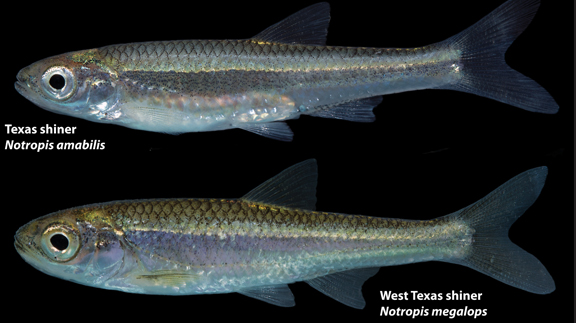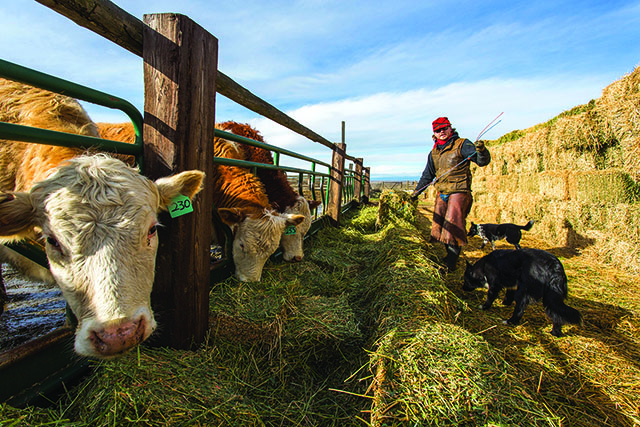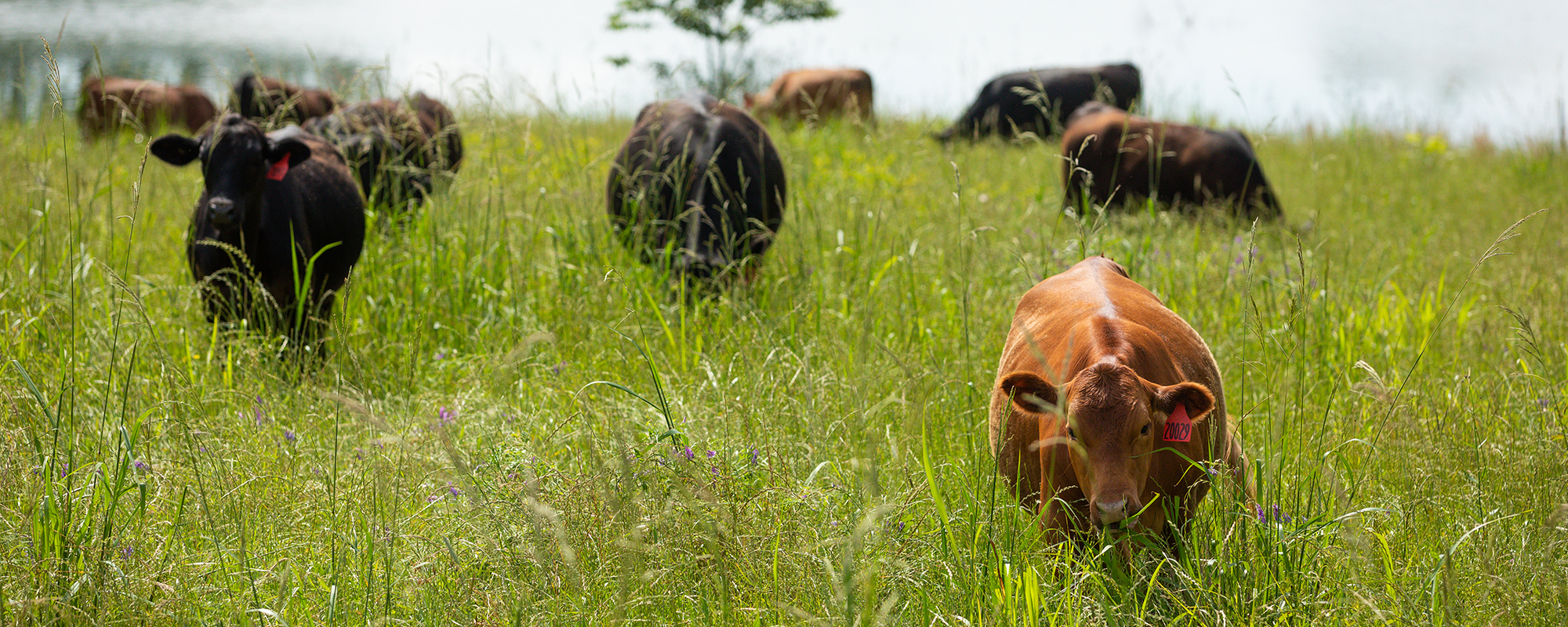HOME
[AgriLife Today] ‘Forgotten’ fish turns up in West Texas

By: Steve Byrns
Minnow rediscovered by AgriLife scientists
Writer: Steve Byrns, 325-653-4576, [email protected]
Contact: Dr. Kevin Conway, 979-845-2620, [email protected]
COLLEGE STATION – With no more “swimmable” water than thirsty West Texas has, it’s hard to imagine a fish, even a minnow-sized fish could remain “missing” for more than a century. But due to a case of mistaken identity, such is the case, said a Texas A&M AgriLife Research scientist.
Dr. Kevin Conway, AgriLife Research wildlife and fisheries scientist, College Station, and Daemin Kim, a former graduate student of Conway’s now at Ewha Womans University, Seoul, South Korea, collaborated on the paper “Redescription of the Texas shiner Notropis amabilis from the southwestern U.S. and northern Mexico with the reinstatement of N. megalops.”
The paper was published in the journal Ichthyological Exploration of Freshwaters, verlag.de/04biol/pdf/ief26_4_03.pdf .
“Notropis megalops, the scientific name of the newly discovered fish, is a new species for Texas, though it’s not ‘really’ a new species,” said Conway, the paper’s lead author. “Charles Frederic Girard, an early day scientist who documented many new species, beat us to the find in 1856, but Girard’s discovery has been dismissed since the 1860s.”
Conway said Girard described many new species of fish, amphibians and reptiles from the southwestern and central U.S., with most collected during the U.S. and Mexican boundary surveys between 1853-1855. But Conway said some of his contemporaries thought Girard was a bit “careless,” saying he sometimes described the same species more than once, which may have led to the current confusion.
“So I guess you could say we have discovered an ‘old-but-new’ minnow way out in West Texas where nobody expected to find anything new, especially a fish,” Conway said. “Though we can’t give this species a new scientific name, we are proposing the common name of West Texas shiner, though the species is also found in adjacent parts of Mexico.”
Conway said their paper documents the rediscovery of the minnow and the confusion surrounding it. That confusion arose because another minnow, the Texas shiner or Notropis amabilis, and the rediscovered minnow were thought to be one and the same, so it was not recognized as a valid separate species.
But based on Conway’s and Kim’s detailed study using genetics and morphology, they have shown that Notropis megalops and Notropis amabilis are in fact two very different fish and are valid but separate species.
“They do look a lot alike, thus the confusion,” Conway said. “But they do not interbreed, and they are actually not even closely related, although they were considered to be the same thing for the last 120 years or so.
“Unlike the Texas shiner, which is common in Central Texas, the West Texas shiner is restricted entirely to the Rio Grande drainage, has a fragmented distribution and has low levels of genetic diversity,” Conway said. “As such, it is already being considered a conservation priority by state agencies.”
So what restrictions does the minnow’s newfound status place on landowners along the minnows’ haunts? Not to worry, said an expert on the topic.
Dr. Gary Garrett, former Texas Parks and Wildlife Department director of watershed conservation and now research scientist at the Texas Natural History Collections, University of Texas at Austin, had this to add about the West Texas shiner:
“The Texas Parks and Wildlife Department maintains a list of species that are in need of conservation efforts, officially called Species of Greatest Conservation Need. Although there are no regulatory actions associated with the listing, it does call attention to impending problems and provides incentives for research and conservation.”
Garrett said the distribution of the West Texas shiner is similar to many other fish that have already been recognized as imperiled such as manantial roundnose minnow, Devils River minnow, Tamaulipas shiner, Rio Grande shiner, longlip jumprock, Mexican redhorse, spotfin gambusia, blotched gambusia, Conchos pupfish, Rio Grande largemouth bass and Rio Grande darter.
“All Texans should be concerned when beautiful and previously pristine habitats are in decline and portions of our state’s natural resources are at risk of being lost,” he said.
“Finding this minnow just goes to show that we still don’t know everything about the fauna that we share our state with,” Conway said. “Discoveries or rediscoveries can still be made, justifying the need for continuing research in the rivers and streams of Texas.”
-30-
LikeTweet
Find more stories, photos, videos and audio at http://today.agrilife.org
HOME
Farm and Ranch Injuries

By Barry Whitworth, DVM
In January, I attended the Oklahoma Veterinary Conference. While waiting for one of the sessions to start, a classmate of mine commented how many of the attendees walk with a limp, used a cane, and/or have damaged hands. We all agreed that working with animals is hard on the body. In general, anything associated with farming and ranching is dangerous.
Most farmers and ranchers know that agriculture is a dangerous occupation. According to United States Bureau of Statistics, workers involved in agriculture, forestry, and fishing had the highest occupational fatality rate in 2022. The fatality rate of 23.5 per 100,000 full-time equivalent (FTE) workers for this group is much higher when compared to the overall occupation fatality rate of 3.7 per 100,000 FTE. Most of the agriculture-related fatalities are associated with transportation, such as tractor overturns, and vehicle crashes, but a fair number involve livestock.
To read more, pick up a copy of the March issue of NTFR magazine. To subscribe by mail, call 940-872-5922.
HOME
Jesses Jewelz

By Jesse Kader
Comfy and keep it western. That’s the name of the game this month. It’s hot and who wants clingy clothing? This jumpsuit is perfectly comfortable and relaxed without forfeiting the fashion. Dress it up or keep it casual. See this and more at www.jessesjewelz.com.
HOME
Noble Research Institute Expands New Program Offering Farmers and Ranchers the Essentials of Regenerative Ranch Management

The educational program has been expanded to three new locations, empowering ranchers and farmers to monitor and improve the health of their land, livestock and livelihood through regenerative principles.
ARDMORE, OK–September 12, 2023 – Noble Research Institute announced the expansion of Essentials of Regenerative Ranching, a new educational program designed to help ranchers enhance and restore the land, making it more resilient and reaching livestock grazing goals through regenerative management. Essentials of Regenerative Ranching provides producers with practical tools, hands-on experience and guidance to make data-driven decisions to decrease costs and improve profit.
The Essentials of Regenerative Ranching course has been expanded to three new locations in Texas and Oklahoma. Registration is open now at www.noble.org/essentials. Seating is limited, so early registration is recommended.
Texas A&M
College Station, Texas
October 17 – 18
O.D. Butler, Jr. Animal Science Complex
Noble Research Institute
Ardmore, Oklahoma
October 31 – November 1
Pavilion Center
Texas A&M
Kingsville, Texas
November 7-8
Caesar Kleberg Wildlife Center
“Program participants gain working knowledge and experience of monitoring and improving the health of their soil, grazing livestock more strategically and making informed financial decisions,” said Hugh Aljoe, Noble Research Institute’s director of ranches, outreach and partnerships. “We use a mix of classroom and field work to send producers home with the tools they need to begin making changes on their ranch.”
Farmers and ranchers navigate uncertainty from weather, fluctuating market prices and escalating costs of inputs. Many producers are seeking new tools that offer greater control and reduce their operational uncertainty. Through this course, ranchers and farmers will calculate their financial situations, determine initial stocking rates, carrying capacity and grazing goals.
“The course is well-suited for ranchers of all experience levels and all types and sizes of operations,” Aljoe added. “No matter your situation, this program will transform the way you think about your ranch.”
The Essentials of Regenerative Ranching program allows producers to overcome obstacles, become more informed problem-solvers and increase the productivity of their grazing lands. By participating in this program, ranchers join a community of like-minded producers who are shaping the future of ranching and leaving a lasting impact on their land and families. “If I had known what I learned in this course when I started my regenerative journey, I could have avoided some key mistakes,” said Tana McCarter, a rancher, and Essentials attendee. “I left with the tools I needed to monitor my soil health and financial progress. I’ll now have the right data to make informed decisions on how to meet my regenerative goals.”
Noble Research Institute is an independent nonprofit agricultural research organization dedicated to guiding farmers and ranchers in applying regenerative principles that yield healthier soil, more productive grazing land, and business success.
At Noble, researchers, facilitators and ranch staff work together to share with farmers and ranchers the skills and tools to regenerate the land in a profitable manner. Noble is focused on the regenerative management of the nation’s grazing acres, which directly impacts pasture and range environments, wildlife, pecan production, and livestock production. Regenerative management recognizes that each decision made on the ranch impacts the interactions of the soil, plants, water, animals, economics and people. Noble’s 14,000 acres of working ranch lands provide a living laboratory on which to demonstrate and practice regenerative principles and ideas to deliver value to farmers and ranchers across the U.S.
-

 Country Lifestyles1 year ago
Country Lifestyles1 year agoScott & Stacey Schumacher: A Growth Mindset
-

 Equine7 months ago
Equine7 months agoThe Will to Win
-

 Country Lifestyles7 years ago
Country Lifestyles7 years agoStyle Your Profile – What your style cowboy hat says about you and new trends in 2017
-

 Country Lifestyles4 years ago
Country Lifestyles4 years agoAmber Crawford, Breakaway Roper
-

 HOME7 years ago
HOME7 years agoGrazing North Texas – Wilman Lovegrass
-

 Country Lifestyles7 years ago
Country Lifestyles7 years agoDecember 2016 Profile, Rusty Riddle – The Riddle Way
-

 Country Lifestyles8 years ago
Country Lifestyles8 years agoJune 2016 Profile – The man behind the mic: Bob Tallman
-

 Outdoor9 years ago
Outdoor9 years agoButtercup or Primrose?






